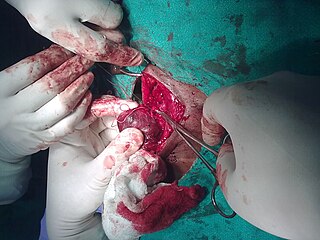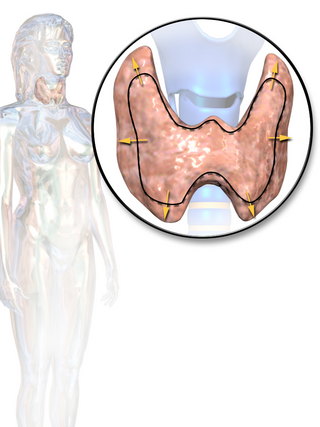Related Research Articles

Congenital iodine deficiency syndrome (CIDS), also called cretinism, is a medical condition present at birth marked by impaired physical and mental development, due to insufficient thyroid hormone production (hypothyroidism) often caused by insufficient dietary iodine during pregnancy. It is one cause of underactive thyroid function at birth, called congenital hypothyroidism. If untreated, it results in impairment of both physical and mental development. Symptoms may include: goiter, poor length growth in infants, reduced adult stature, thickened skin, hair loss, enlarged tongue, a protruding abdomen, delayed bone maturation and puberty in children, mental deterioration, neurological impairment, impeded ovulation, and infertility in adults.

A goitre, or goiter, is a swelling in the neck resulting from an enlarged thyroid gland. A goitre can be associated with a thyroid that is not functioning properly.

Hyperthyroidism is the condition that occurs due to excessive production of thyroid hormones by the thyroid gland. Thyrotoxicosis is the condition that occurs due to excessive thyroid hormone of any cause and therefore includes hyperthyroidism. Some, however, use the terms interchangeably. Signs and symptoms vary between people and may include irritability, muscle weakness, sleeping problems, a fast heartbeat, heat intolerance, diarrhea, enlargement of the thyroid, hand tremor, and weight loss. Symptoms are typically less severe in the elderly and during pregnancy. An uncommon but life-threatening complication is thyroid storm in which an event such as an infection results in worsening symptoms such as confusion and a high temperature; this often results in death. The opposite is hypothyroidism, when the thyroid gland does not make enough thyroid hormone.

Graves' disease, also known as toxic diffuse goiter or Basedow’s disease, is an autoimmune disease that affects the thyroid. It frequently results in and is the most common cause of hyperthyroidism. It also often results in an enlarged thyroid. Signs and symptoms of hyperthyroidism may include irritability, muscle weakness, sleeping problems, a fast heartbeat, poor tolerance of heat, diarrhea and unintentional weight loss. Other symptoms may include thickening of the skin on the shins, known as pretibial myxedema, and eye bulging, a condition caused by Graves' ophthalmopathy. About 25 to 30% of people with the condition develop eye problems.

A thyroidectomy is an operation that involves the surgical removal of all or part of the thyroid gland. In general surgery, endocrine or head and neck surgeons often perform a thyroidectomy when a patient has thyroid cancer or some other condition of the thyroid gland or goiter. Other indications for surgery include cosmetic, or symptomatic obstruction. Thyroidectomy is a common surgical procedure that has several potential complications or sequelae including: temporary or permanent change in voice, temporary or permanently low calcium, need for lifelong thyroid hormone replacement, bleeding, infection, and the remote possibility of airway obstruction due to bilateral vocal cord paralysis. Complications are uncommon when the procedure is performed by an experienced surgeon.

Hashimoto's thyroiditis, also known as chronic lymphocytic thyroiditis, Hashimoto's disease, and autoimmune thyroiditis is an autoimmune disease in which the thyroid gland is gradually destroyed.

Levothyroxine, also known as L-thyroxine, is a synthetic form of the thyroid hormone thyroxine (T4). It is used to treat thyroid hormone deficiency (hypothyroidism), including a severe form known as myxedema coma. It may also be used to treat and prevent certain types of thyroid tumors. It is not indicated for weight loss. Levothyroxine is taken orally (by mouth) or given by intravenous injection. Levothyroxine has a half-life of 7.5 days when taken daily, so about six weeks is required for it to reach a steady level in the blood.

Propylthiouracil (PTU) is a medication used to treat hyperthyroidism. This includes hyperthyroidism due to Graves' disease and toxic multinodular goiter. In a thyrotoxic crisis it is generally more effective than methimazole. Otherwise it is typically only used when methimazole, surgery, and radioactive iodine is not possible. It is taken by mouth.
Iodine deficiency is a lack of the trace element iodine, an essential nutrient in the diet. It may result in metabolic problems such as goiter, sometimes as an endemic goiter as well as congenital iodine deficiency syndrome due to untreated congenital hypothyroidism, which results in developmental delays and other health problems. Iodine deficiency is an important global health issue, especially for fertile and pregnant women. It is also a preventable cause of intellectual disability.

Thyroid disease is a medical condition that affects the function of the thyroid gland. The thyroid gland is located at the front of the neck and produces thyroid hormones that travel through the blood to help regulate many other organs, meaning that it is an endocrine organ. These hormones normally act in the body to regulate energy use, infant development, and childhood development.

Toxic multinodular goiter (TMNG), also known as multinodular toxic goiter (MNTG), is an active multinodular goiter associated with hyperthyroidism.

Bannayan–Riley–Ruvalcaba syndrome (BRRS) is a rare overgrowth syndrome and hamartomatous disorder with occurrence of multiple subcutaneous lipomas, macrocephaly and hemangiomas. The disease is inherited in an autosomal dominant manner. The disease belongs to a family of hamartomatous polyposis syndromes, which also includes Peutz–Jeghers syndrome, juvenile polyposis and Cowden syndrome. Mutation of the PTEN gene underlies this syndrome, as well as Cowden syndrome, Proteus syndrome, and Proteus-like syndrome, these four syndromes are referred to as PTEN Hamartoma-Tumor Syndromes.
The Academy of Clinical Thyroidologists (ACT) was founded in May 2005 at the annual meeting of the Association of Clinical Endocrinologists (AACE) in Washington, D.C. The academy is a professional society consisting of 32 members from the U.S. and Italy who specialize in clinical thyroidology. ACT encourages skill development in diagnostic and interventional ultrasound, nuclear thyroidology, and cytopathology to promote excellence in clinical practice and optimal outcomes for patients.

A thyroid adenoma is a benign tumor of the thyroid gland, that may be inactive or active as a toxic adenoma.
Nodular goiter is an enlarged thyroid gland with bumps (nodules) on it. It is associated with both high and low activity of the gland.
Liotrix is a 4:1 mixture of thyroxine (T4) and triiodothyronine (T3) made synthetically. It is used to replenish thyroid hormones in thyroid deficiency and hypothyroidism. The only brand of liotrix available in the U.S. is Thyrolar, manufactured by Forest Laboratories.

Colloid nodules, also known as adenomatous nodules or colloid nodular goiter are benign, noncancerous enlargement of thyroid tissue. Although they may grow large, and there may be more than one, they are not malignant and they will not spread beyond the thyroid gland. Colloid nodules are the most common kind of thyroid nodule.

A cold nodule is a thyroid nodule that does not produce thyroid hormone. On a radioactive iodine uptake test a cold nodule takes up less radioactive material than the surrounding thyroid tissue. A cold nodule may be malignant or benign. On scintigraphy cold nodules do not show but are easily shown on ultrasound. Figure 1 illustrates the basic anatomy of the thyroid gland. The case shown in Figure 4 shows a cold nodule quite emphasized representation of the thyroid. The investigation was carried out due to a goiter rating of 3. Striking was the discrepancy between the magnification sonographically depicted the thyroid lobe and the findings in the scintigraphy; the lower part of the right lobe and the lateral part of the left missing in the bone scan, although demonstrably thyroid tissue is present there sonographically. This imperfective representation for thyroid tissue is the characteristic of a "cold node". Cold nodules are common in older women and are usually benign, with only 15-20% being malignant. In men or children, cold nodules are much less common, and presumed to be cancerous until proven otherwise.
In CT scan of the thyroid, focal and diffuse thyroid abnormalities are commonly encountered. These findings can often lead to a diagnostic dilemma, as the CT reflects nonspecific appearances. Ultrasound (US) examination has a superior spatial resolution and is considered the modality of choice for thyroid evaluation. Nevertheless, CT detects incidental thyroid nodules (ITNs) and plays an important role in the evaluation of thyroid cancer.
References
- 1 2 Randolph, Gregory (2012). Surgery of the Thyroid and Parathyroid Glands: Expert Consult Premium Edition — Enhanced Online Features and Print. Elsevier Health Sciences. p. 89. ISBN 978-1437722277.
- ↑ Gnepp, Douglas R. (2009). Diagnostic Surgical Pathology of the Head and Neck (2 ed.). Elsevier Health Sciences. p. 580. ISBN 978-1437719512.